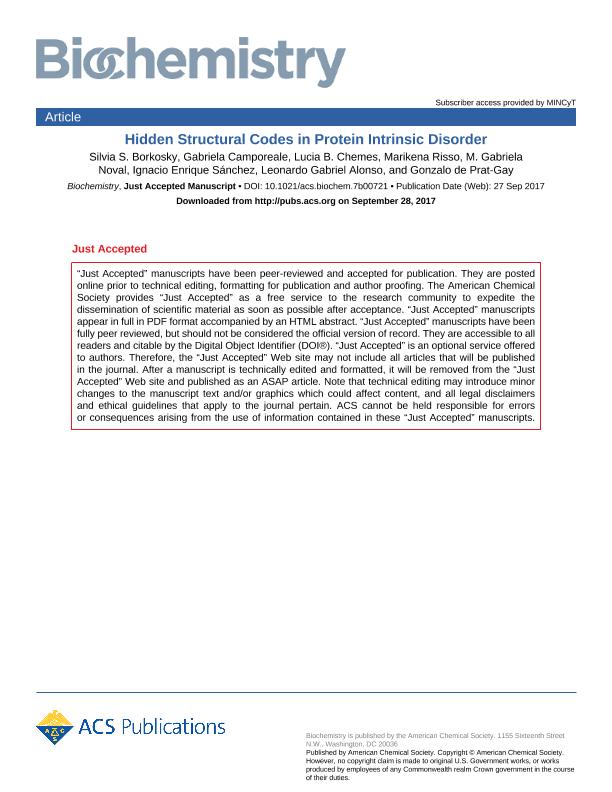Artículo
Hidden Structural Codes in Protein Intrinsic Disorder
Borkosky, Silvia Susana ; Camporeale, Gabriela
; Camporeale, Gabriela ; Chemes, Lucia Beatriz
; Chemes, Lucia Beatriz ; Risso, Marikena Guadalupe
; Risso, Marikena Guadalupe ; Noval, María Gabriela
; Noval, María Gabriela ; Sánchez Miguel, Ignacio Enrique
; Sánchez Miguel, Ignacio Enrique ; Alonso, Leonardo Gabriel
; Alonso, Leonardo Gabriel ; de Prat Gay, Gonzalo
; de Prat Gay, Gonzalo
 ; Camporeale, Gabriela
; Camporeale, Gabriela ; Chemes, Lucia Beatriz
; Chemes, Lucia Beatriz ; Risso, Marikena Guadalupe
; Risso, Marikena Guadalupe ; Noval, María Gabriela
; Noval, María Gabriela ; Sánchez Miguel, Ignacio Enrique
; Sánchez Miguel, Ignacio Enrique ; Alonso, Leonardo Gabriel
; Alonso, Leonardo Gabriel ; de Prat Gay, Gonzalo
; de Prat Gay, Gonzalo
Fecha de publicación:
10/2017
Editorial:
American Chemical Society
Revista:
Biochemistry
ISSN:
0006-2960
e-ISSN:
1520-4995
Idioma:
Inglés
Tipo de recurso:
Artículo publicado
Clasificación temática:
Resumen
Intrinsic disorder is a major structural category in biology, accounting for more than 30% of coding regions across the domains of life, yet consists of conformational ensembles in equilibrium, a major challenge in protein chemistry. Anciently evolved papillomavirus genomes constitute an unparalleled case for sequence to structure-function correlation in cases in which there are no folded structures. E7, the major transforming oncoprotein of human papillomaviruses, is a paradigmatic example among the intrinsically disordered proteins. Analysis of a large number of sequences of the same viral protein allowed for the identification of a handful of residues with absolute conservation, scattered along the sequence of its N-terminal intrinsically disordered domain, which intriguingly are mostly leucine residues. Mutation of these led to a pronounced increase in both α-helix and β-sheet structural content, reflected by drastic effects on equilibrium propensities and oligomerization kinetics, and uncovers the existence of local structural elements that oppose canonical folding. These folding relays suggest the existence of yet undefined hidden structural codes behind intrinsic disorder in this model protein. Thus, evolution pinpoints conformational hot spots that could have not been identified by direct experimental methods for analyzing or perturbing the equilibrium of an intrinsically disordered protein ensemble
Palabras clave:
Protein
,
Intrinsic Disorder
,
Oncoprotein
,
Folding
Archivos asociados
Licencia
Identificadores
Colecciones
Articulos(IIBBA)
Articulos de INST.DE INVEST.BIOQUIMICAS DE BS.AS(I)
Articulos de INST.DE INVEST.BIOQUIMICAS DE BS.AS(I)
Citación
de Prat Gay, Gonzalo; Alonso, Leonardo Gabriel; Sánchez Miguel, Ignacio Enrique; Noval, María Gabriela; Risso, Marikena Guadalupe; Chemes, Lucia Beatriz; et al.; Hidden Structural Codes in Protein Intrinsic Disorder; American Chemical Society; Biochemistry; 56; 41; 10-2017; 5560-5569
Compartir
Altmétricas



